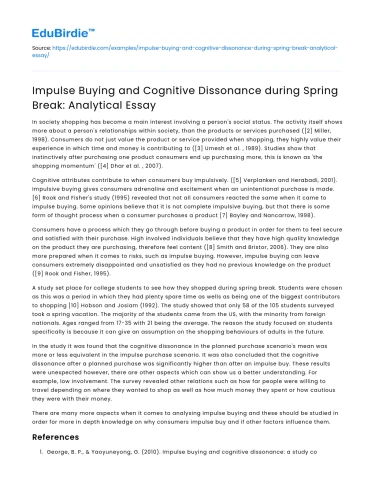In society shopping has become a main interest involving a person's social status. The activity itself shows more about a person's relationships within society, than the products or services purchased ([2] Miller, 1998). Consumers do not just value the product or service provided when shopping, they highly value their experience in which time and money is contributing to ([3] Umesh et al. , 1989). Studies show that instinctively after purchasing one product consumers end up purchasing more, this is known as 'the shopping momentum' ([4] Dhar et al. , 2007).
Cognitive attributes contribute to when consumers buy impulsively. ([5] Verplanken and Herabadi, 2001). Impulsive buying gives consumers adrenaline and excitement when an unintentional purchase is made. [6] Rook and Fisher's study (1995) revealed that not all consumers reacted the same when it came to impulse buying. Some opinions believe that it is not complete impulsive buying, but that there is some form of thought process when a consumer purchases a product [7] Bayley and Nancarrow, 1998).
Save your time!
We can take care of your essay
- Proper editing and formatting
- Free revision, title page, and bibliography
- Flexible prices and money-back guarantee
Consumers have a process which they go through before buying a product in order for them to feel secure and satisfied with their purchase. High involved individuals believe that they have high quality knowledge on the product they are purchasing, therefore feel content ([8] Smith and Bristor, 2006). They are also more prepared when it comes to risks, such as impulse buying. However, impulse buying can leave consumers extremely disappointed and unsatisfied as they had no previous knowledge on the product ([9] Rook and Fisher, 1995).
A study set place for college students to see how they shopped during spring break. Students were chosen as this was a period in which they had plenty spare time as wells as being one of the biggest contributors to shopping [10] Hobson and Josiam (1992). The study showed that only 58 of the 105 students surveyed took a spring vacation. The majority of the students came from the US, with the minority from foreign nationals. Ages ranged from 17-35 with 21 being the average. The reason the study focused on students specifically is because it can give an assumption on the shopping behaviours of adults in the future.
In the study it was found that the cognitive dissonance in the planned purchase scenario's mean was more or less equivalent in the impulse purchase scenario. It was also concluded that the cognitive dissonance after a planned purchase was significantly higher than after an impulse buy. These results were unexpected however, there are other aspects which can show us a better understanding. For example, low involvement. The survey revealed other relations such as how far people were willing to travel depending on where they wanted to shop as well as how much money they spent or how cautious they were with their money.
There are many more aspects when it comes to analysing impulse buying and these should be studied in order for more in depth knowledge on why consumers impulse buy and if other factors influence them.
References
- George, B. P., & Yaoyuneyong, G. (2010). Impulse buying and cognitive dissonance: a study conducted among the spring break student shoppers. Young Consumers, 11(4), 291-306.
- Miller, D. (1998), A Theory of Shopping, Cornell University Press, Ithaca, NY.
- Umesh, U.N., Pettit, K.L. and Bozman, C.S. (1989), 'Shopping model of the time-sensitive consumer', Decision Sciences, Vol. 20 No. 4, pp. 715-29.
- Dhar, R., Huber, J. and Khan, U. (2007), 'The shopping momentum effect', Journal of Marketing Research, Vol. 44 No. 3, pp. 370-8.
- Verplanken, B. and Herabadi, A. (2001), 'Individual differences in impulse buying tendency: feeling and no thinking', European Journal of Personality, Vol. 15 No. 1, pp. 71-83.
- Rook, D. and Fisher, R.J. (1995), 'Trait and normative aspects of impulsive buying behavior', Journal of Consumer Research, Vol. 22 No. 3, pp. 305-13.
- Bayley, G. and Nancarrow, C. (1998), 'Impulse purchasing: a qualitative exploration of the phenomenon', Qualitative Market Research: An International Journal, Vol. 1 No. 2, pp. 99-114.
- Smith, J.B. and Bristor, J.M. (2006), 'Uncertainty orientation: explaining differences in purchase involvement and external search', Psychology and Marketing, Vol. 11 No. 6, pp. 587-607.
- Rook, D. and Fisher, R.J. (1995), 'Trait and normative aspects of impulsive buying behavior', Journal of Consumer Research, Vol. 22 No. 3, pp. 305-13.
- Hobson, J.S.P. and Josiam, B. (1992), 'Spring break student travel: an exploratory study', Journal of Travel and Tourism Marketing, Vol. 1 No. 3, pp. 87-97.
Did you like this example?
Make sure you submit a unique essay
Our writers will provide you with an essay sample written from scratch: any topic, any deadline, any instructions.
Cite this paper
-
APA
-
MLA
-
Harvard
-
Vancouver
Impulse Buying & Cognitive Dissonance in Spring Break: Analysis.
(2022, August 12). Edubirdie. Retrieved December 22, 2024, from https://edubirdie.com/examples/impulse-buying-and-cognitive-dissonance-during-spring-break-analytical-essay/
“Impulse Buying & Cognitive Dissonance in Spring Break: Analysis.” Edubirdie, 12 Aug. 2022, edubirdie.com/examples/impulse-buying-and-cognitive-dissonance-during-spring-break-analytical-essay/
Impulse Buying & Cognitive Dissonance in Spring Break: Analysis. [online].
Available at: <https://edubirdie.com/examples/impulse-buying-and-cognitive-dissonance-during-spring-break-analytical-essay/> [Accessed 22 Dec. 2024].
Impulse Buying & Cognitive Dissonance in Spring Break: Analysis [Internet]. Edubirdie.
2022 Aug 12 [cited 2024 Dec 22].
Available from: https://edubirdie.com/examples/impulse-buying-and-cognitive-dissonance-during-spring-break-analytical-essay/
copy






 Stuck on your essay?
Stuck on your essay?

